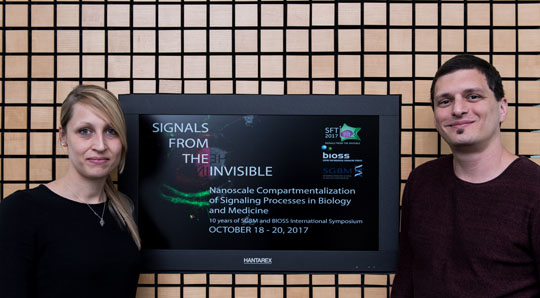Ten years of excellent research
Freiburg, Jun 01, 2017
Two centers of excellence are celebrating their tenth year anniversary: The Spemann Graduate School of Biology and Medicine (SGBM) and the excellence cluster BIOSS Centre for Biological Signalling Studies are hosting the international symposium „Signals from the Invisible" from October 18-20, 2017. Registration is open until July 31, 2017.
 Hanna Wagner and Marco Cavallari are leading the organizational team for the symposium „Signals from the Invisible."
Hanna Wagner and Marco Cavallari are leading the organizational team for the symposium „Signals from the Invisible."
Photo: Patrick Seeger
Making visible that which cannot be seen with the naked eye or even a microscope: That is the theme of the symposium „Signals from the Invisible" with which both institutions at the University of Freiburg, who were both successful in the first two rounds of the excellence competition, will be celebrating their tenth anniversary in Forum Merzhausen October 18-20,2017. "Our focus are new techniques and methods with which we can observe and examine signalling pathways in cells at the nanondimensional level," says Hanna Wagner, biologist and doctoral student at the Spemann Graduate School of Biology and Medicine (SGBM). "We are pleased to have gained top international researchers from the fields of nanothechnology and signalling research for the symposium," adds Dr. Marco Cavallari, biologist and lecturer at the excellence cluster BIOSS Centre for Biological Signalling Studies. "The program shows what is currently possible in this area." For instance, how movements can be captured using a resolution of ten to one hundred nanometers in an electron microscope – a nanometer is the millionth unit of one millimeter.
One-and-a-half years of lead time
Marco Cavallari and Hanna Wagner are leading the organizational team that includes five other young researchers from SGBM and supports the BIOSS Office. The group took on the work about a year ago. That is how much lead time is necessary if such an internationally star-studded event with 400 to 500 participants is to be successful. Finding the appropriate event location, asking speakers about their availability at least a year in advance, planning the budget and getting sponsors on board, putting together the catering, creating a Website, and on, and on, and on: „"We learned so much about project management," says Hanna Wagner. "Having such a skill will most definitely come in handy in the future." The team divided the tasks into various sections. They meet around once a month to discuss next steps – right now they are discussing how to organize the evening event in the Peterhofkeller to give participants time to network and exchange ideas in a relaxed environment.
Anyone interested is welcome to attend
The main audience includes members of both excellence centers, in particular the doctoral students. They will have an opportunity, among other things, to present their work with a poster or even a mini-presentation in order to receive feedback from international experts in the field. "But the symposium is open to anyone," claims Marco Cavallari. "For instance, less advanced students who already know they are interested in signalling research because they may wish to enter the field of cancer research are equally welcome." SGBM doctoral students receive free admission; students are required to pay a 100 Euro conference fee; BIOSS members pay 150 Euros and all other participants pay 200 Euros. Registration is open until July 31, 2017 via the symposium Website.
Shaped by excellence
Both Hanna Wagner and Marco Cavallari agree: The Freiburg excellence centers have clearly shaped their scientific career path up to this point. Prior to this time, Cavallari was conducting research in the US where he met BIOSS spokesperson Prof. Dr. Michael Reth in his lab. For the past two-and-a-half years he has been a lecturer at BIOSS and a member of Reth's working group. He is currently exploring the behavior of B-cell receptors on the nano level. These receptors recognize foreign molecules such as pathogens or vaccines and activate the B-cells that are located on their surface in order to produce antibodies. "The collaboration within the BIOSS working groups, the weekly BIOSS seminars and the signal house serves as a communication platform and support the members' research and career goals," says Cavallari.
Wagner was involved first as a student, then during her diplom thesis as an advisor in the BIOSS team for „international Genetically Engineered Machine" (iGEM), an international student competition in the field of synthetic biology. She is currently conducting lab research at BIOSS under Prof. Dr. Wilfried Weber. Her work focuses on proteins that help give materials new properties: such as how they detect toxins in food or release medication in a controlled fashion directly where it is needed. She will complete her doctorate at the SGBM. Whether it is the infrastructure, organization, soft skills program, exchange with colleagues or friendships that have emerged over time: "This is the best thing that could have ever happened to me."
Nicolas Scherger

